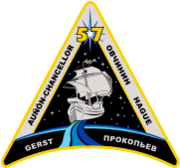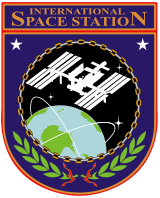Expedition 57
| Mission type | ISS Expedition |
|---|---|
| Expedition | |
| Space Station | International Space Station |
| Arrived aboard |
Soyuz MS-09 Soyuz MS-10 (failed) |
| Departed aboard | Soyuz MS-09 |
| Crew | |
| Crew size | 5 (planned) |
| Members |
Alexander Gerst Serena M. Auñón-Chancellor Sergey Prokopyev Further members TBD |
|
 (l-r) Serena Auñón-Chancellor of NASA, Commander Alexander Gerst from the European Space Agency and Sergei Prokopev of Roscosmos. In the back row from left are Flight Engineers Aleksey Ovchinin of Roscosmos and Nick Hague from NASA. | |
Expedition 57 is the 57th expedition to the International Space Station, which began on October 4, 2018 upon the departure of Soyuz MS-08. Alexander Gerst, Serena M. Auñón-Chancellor, and Sergey Prokopyev, currently aboard the ISS, were expected to be joined by Aleksey Ovchinin and Nick Hague.[1] The latter two crew members boarded Soyuz MS-10 on October 11, 2018, but the launch was aborted mid-flight due to a booster failure; the crew landed safely after a ballistic descent.[2][3]
As of October 11, 2018, it is not known what impact the Soyuz MS-10 failure and subsequent investigation will have on the ISS crew schedule.[4] The expedition crew can return safely in Soyuz MS-09; under existing plans, they would nominally have to leave by mid-December due to the limited on-orbit lifespan of "about 200 days" of the Soyuz capsule, or early January allowing for a small margin on the lifespan. While NASA will attempt to avoid de-crewing the ISS, commanding the station from the ground is feasible if necessary.[5]
Crew
| Position | First part
(since October 2018) |
Second part
(October – December 2018) |
|---|---|---|
| Commander | Second spaceflight[6] | |
| Flight Engineer 1 | First spaceflight[7] | |
| Flight Engineer 2 | First spaceflight | |
| Flight Engineer 3 | Second spaceflight | |
| Flight Engineer 4 | First spaceflight | |
Originally NASA Astronaut Jeanette Epps was assigned as flight engineer for Expeditions 56 and 57, becoming the first African American space station crew member[8] and the 15th African American to fly in space, but on January 16, 2018, NASA announced that Epps had been replaced by her backup Serena M. Auñón-Chancellor.[9]
Cosmonaut Nikolai Tikhonov was slated to make his first spaceflight on the Soyuz MS-10 spacecraft, but was removed from the crew due to delays in launching the Russian Nauka module. This is the second time that Tikhonov has been removed from an ISS crew for such reason.[10][11]
References
- ↑ "Future Expeditions". NASA. May 9, 2018. Retrieved June 5, 2018.
- ↑ Dent, Steve (11 October 2018). "Soyuz astronauts safe after failure forced an emergency landing". Engadget. Retrieved 11 October 2018.
- ↑ "Family, world watches as rocket carrying Kansas astronaut fails". The Wichita Eagle. October 11, 2018. Archived from the original on October 12, 2018.
- ↑ Berger, Eric (11 October 2018). "A Soyuz crew makes an emergency landing after rocket fails". Ars Technica. Retrieved 11 October 2018.
- ↑ Foust, Jeff (11 October 2018). "NASA to look at options to keep crew on ISS while Soyuz grounded". SpaceNews.
- ↑ "Alexander Gerst". ESA. 9 February 2018. Retrieved 12 March 2018.
- ↑ "Serena M. Auñón-Chancellor (M.D.) NASA Astronaut". NASA. 3 August 2017. Retrieved 12 March 2018.
- ↑ Karen Northon (January 4, 2017). "NASA Assigns Upcoming Space Station Crew Members". NASA press release 17-001. Retrieved January 21, 2017.
- ↑ Karen Northon (January 18, 2018). "NASA Announces Updated Crew Assignments for Space Station Missions". NASA press release 18-004. Retrieved January 21, 2017.
- ↑ Ben Evans (May 30, 2018). "No U.S. Crew Will Command The International Space Station in 2019". AmericaSpace. Retrieved August 18, 2018.
- ↑ Ben Evans (October 30, 2016). "As Soyuz MS-01 Lands, International Partners Look Ahead to Reduced Crewing in 2017". AmericaSpace. Retrieved August 18, 2018.
External links
- Expedition 57 on Nasa.gov
- Expedition 57 related articles on spaceflightnow.com
| Wikimedia Commons has media related to ISS Expedition 57. |

